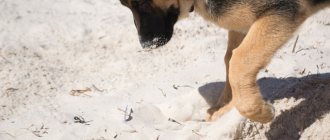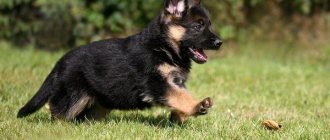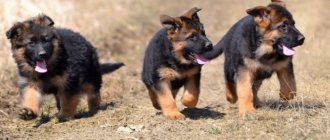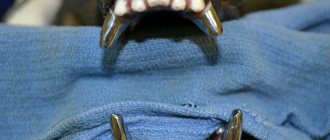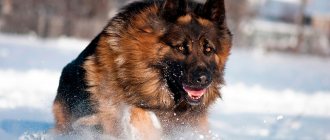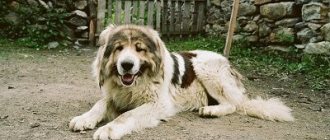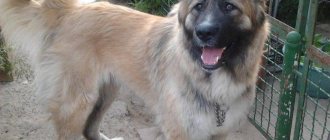The German Shepherd is one of the most common breeds of working dogs in the world. She is perfect for family life because she has a people-oriented personality and is a quick learner. You need to start raising a German Shepherd puppy after 1 month of age, then by the second month he will respond to his name and even follow some commands.
Two month old German Shepherd puppies
Features of keeping a German Shepherd in an apartment
The optimal room temperature for keeping a two-month-old German Shepherd puppy in an apartment is +16-18 degrees. The dog should have its own permanent spacious place with no drafts. An unsuitable place would be near heating devices, in the bathroom, or in the kitchen.
It is necessary to organize a place of residence for a puppy, taking into account a number of rules
It is not allowed to keep a pet in an apartment on a leash or in a fenced area: restriction of movements leads to weakening of the limbs and rickets. You should not allow your baby to jump on the bed or sofa, as it will be difficult to wean him from this habit.
Feeding
As a rule, German Shepherd puppies are handed over to new owners at the age of 45 days. By this period, the puppy’s diet includes chopped meat, buckwheat or rice, and cottage cheese. At this age, feeding should be done every three hours. The meat is chopped and mixed with porridge. Dry cottage cheese should be mixed with kefir or a raw chicken egg.
From three months you can give a little apple. It is useful for German Shepherds to add carrots to their porridge, because... it enhances the pigment of the coat and the color becomes brighter red.
At five months, puppies begin to change their teeth. During this period, it is advisable to choose special vitamins for the puppy that contain calcium, collagen and other important supplements.
From six months they are gradually transferred to three feedings a day. The amount of raw meat is reduced, replacing it with raw offal and offal (liver and heart).
German Shepherds must be given chondroprotectors to maintain healthy joints.
German Shepherds are a breed prone to food allergies. Therefore, it is not recommended to include chicken meat in your diet. You can't give pork or sugar.
German Shepherd puppy 2 months: care features
At this age, the puppy requires special attention and care. The owner needs to observe the rules of hygiene for the baby, take him for walks regularly, help him quickly adapt to new conditions and educate him. An important feature of representatives of this breed is that they do not tolerate loneliness.
The right diet
A shepherd's diet should be balanced and contain meat.
Adequate feeding and a properly selected diet for a German shepherd puppy is the key to its rapid growth, gaining optimal body weight and developing a physique. German Shepherd girls weigh 7.5-8 kg at two months, and boys - from 9 kg. The height at the withers of the female is 35-37 cm, with a chest circumference of 46-49 cm.
The diet should be balanced and varied, providing the dog’s body with all the necessary substances. It is necessary to introduce fresh greens into the diet (finely chopped nettles and scalded with boiling water, carrot and beet tops), and fish oil drops.
Important! If the owner does not know how much food to give the baby and what should be included in it (wet/dry food), you should ask the breeder or veterinarian about this.
Dry food is allowed for young dogs, but you should take into account its classification on the packaging, and it is better to consult a veterinarian before purchasing. If the dog refuses to eat, then dry food can be soaked with clean water or cheese or a little kefir can be added to it.
A two-month-old puppy needs to be fed 5 times a day every 4 hours.
The following foods must be present in your dog’s diet:
- Meat. It should be at least 30% in the diet. It should be fresh and cut into pieces. Any type of meat is allowed, with the exception of pork.
- Bones. To train the jaw muscles, German Shepherd puppies can be given a large sugar bone at two months.
- Fish. Sea fish is given raw, well cleaned of small bones. River fish is acceptable in the diet only in boiled form. The fish portion should be 1.5-2 times larger than the meat portion due to its lower nutritional value.
- Eggs are allowed in the diet no more than twice a week and only boiled.
- Dairy products are the main source of calcium. A two-month-old puppy's diet must include calcined cottage cheese, as well as kefir and yogurt.
- Thick buckwheat or rice porridge is also necessary.
- Rye or gray bread is acceptable only in the form of crackers.
- Pumpkin, zucchini, carrots, cabbage must be finely chopped and served with the addition of a small amount of sunflower oil.
It is necessary to include vegetables, fruits and herbs in your pet’s diet.
Important! Unsuitable for feeding German Shepherd babies: flour products, legumes, smoked foods, potatoes, pickles, sweets, sausages.
Walks
Walking with a two-month-old German Shepherd puppy should be done as often as possible. This is a means of properly responding to the world around us. But their duration and frequency directly depend on weather conditions. When outdoors in cold weather, your pet needs to be constantly on the move. It is important to prevent him from lying or sitting on cold and damp ground.
The pet needs to be allowed to move more during walks.
First, you need to choose quieter places for walks, gradually moving to noisy and crowded ones, accustoming your pet to an unfamiliar environment. If the puppy reacts negatively to external stimuli and gets scared, it should be distracted and calmed down.
Important! To avoid contracting diseases, the baby should not be allowed near stray dogs.
From two months old, you can accustom your German Shepherd puppy to a leash with a soft collar. Distances during walks should not exceed 3 km, as if overtired the animal may temporarily lose its appetite.
Bathing a puppy
It is necessary to care for your pet from the first day it arrives in the house. It is not recommended to wash a German Shepherd puppy under water until three months of age. If there are stains, it is enough to wipe them with a damp cloth soaked in clean warm water. From three months onwards, you need to bathe your puppy using a special shampoo 1-2 times a year. The water should be warm (+36-40 degrees). After walking, if necessary, the kitten can be rinsed with water or wiped with a damp cloth.
Grooming
A German Shepherd puppy needs to be brushed regularly. This is done using a comb, a brush, and then a cloth. This treatment massages the skin and removes dirt from your puppy's coat.
Ear care
The dog's ears also need to be given attention. The ears should be regularly treated with damp gauze using gentle movements. There is no need to rub them excessively. Cleaning should be carried out no more than once a month.
Eye care
For kitten eye hygiene you need to have a special solution. You can buy it at pet stores or veterinary pharmacies. Regular eye cleaning is a must for puppies who live in the yard.
Dental care
It is especially important for owners whose puppy eats dry food to monitor the condition of their pet’s teeth.
On a note! Tooth powders for dogs or chew sticks can help keep your mouth clean.
Toilet training
It’s time to train a two-month-old puppy to use a special toilet. You cannot punish a puppy for his mistakes in the apartment: scream, hit, poke his face into a puddle.
When toilet training your puppy, you should know that the desire to defecate occurs immediately after eating and sleeping. Therefore, at such moments it is worth taking it outside for a few minutes to a certain place, developing a habit.
Puppy hygiene must be fully observed
Hygiene procedures
Dog breeders, when explaining how to care for a German Shepherd puppy, always talk about the importance of hygiene procedures. Always monitor the condition of your pupil’s eyes - if there is redness or tearing, frequent blinking, take action immediately. It is recommended to consult a veterinarian, purchase eye drops and wash the dog’s eyes with a cotton pad soaked in chamomile infusion.
Teeth brushing is carried out once every three months - for this purpose you will need to stock up on special toothpaste or powder. To strengthen your baby's teeth, purchase artificial bones containing fluoride or made from leather - they are suitable for cleaning fangs and developing jaws.
Among other things, children need to clean their ears monthly - for this you can use a cotton swab and a special preparation that is sold in veterinary pharmacies. At the same time, conduct a detailed examination of the ears for redness and inflammation - if anything of this kind is found, you should contact a veterinarian.
Owners often wonder why their German Shepherd puppy's ear has fallen off - this fact causes concern for many. Most often there is nothing to worry about, as this happens to many Germans during the period when teeth are growing. Continue to care for your pet, properly balance the diet instead of anxiously writing questions on all forums about why your German Shepherd puppy’s ear fell off - soon everything will return to normal.
As for bathing the baby, there is no need to do this unless absolutely necessary - too frequent washing violates the natural protective layer on the dog’s skin and coat. You can completely bathe your pet starting from the age of three months - it is recommended to wash your shepherd dog no more than three times a year.
If we are talking about removing dust or dirt from a walk, you can simply rinse the dog with warm water. But you should not overuse bath procedures - this will negatively affect the health of the shepherd.
Training German Shepherd puppies
Raising German Shepherd puppies implies the dog's complete affection for the owner and its desire to follow commands. The owner must have a positive attitude towards the ward and patience. The dog will obey only if it respects the “teacher” and feels his advantage.
All the puppy’s actions are determined by his natural instincts and conditioned reflexes. He is able to understand the owner’s actions towards him: punishment is perceived as punishment if it was the result of his mischief immediately, and not after a period of time. A puppy should not bite out of aggression; it is important to stop this.
Important! The owner must achieve the puppy's favor and respect. That is, punishment is a consequence of aggression towards the owner.
In order for the dog to follow commands, it must be involved in the process, create an association with pleasant sensations: treat it with its favorite treat, captivate it with its favorite toy.
It’s better to attract your baby’s attention with your favorite toy.
Interaction with a dog should start with its name. This is the first thing she must learn, and without which she should not begin training and mastering the basics of training.
Command “Come to me!”
If a 2-month-old purebred puppy knows his “name,” then the first command for him to learn will be “Come to me!” It should evoke only positive emotions in the dog. This command is the simplest for the owner: you need to call your pet with a nickname, for example, “Rex, come to me!” For the first time, you can attract the puppy's attention by clapping your hands if the training takes place indoors.
There are two basic rules associated with the “Come to me!” command:
- You should not end your walk with this command, causing unpleasant associations in the puppy.
- You cannot punish a pet for not following a command. When the puppy does approach, he will perceive this punishment incorrectly - as if he was punished for the fact that the puppy approached the owner.
Important! A German Shepherd dog needs a lot of exercise.
Collar and leash training
You can accustom your puppy to a collar from the age of two months, after all preventive vaccinations have been completed. For this age, light leather collars 2-2.5 cm wide are recommended.
First, it is enough to put the product on the puppy and let him walk around during the day, and only after that take him outside. Under no circumstances should you pull on the leash: you need to let the dog understand that it is not limited in its movements and desires. It is enough to attract the puppy's attention with a stick or toy so that he changes the trajectory of his movement.
On a note! When the pet gets used to the collar and leash, it will already have clearly established associations with a walk and with the fact that in this way it is always close to its owner.
Command "Near!"
After mastering the command “Come to me!” you can begin to teach the puppy the “Near!” command, the essence of which is that it is on the left foot of the owner, keeping up with him and not running in front. At first, when training, you need to keep the dog on a leash.
To start training, you need to take a treat for the dog in your hand and hold it in front of it, repeating the command. As soon as the puppy walks correctly at least a couple of meters, give him a treat. Repeat the same steps several times. After just a few days, the dog will get used to the command and will be able to do without treats. Command "Near!" - one of the most difficult to train a puppy, and requires special attention, effort and patience on the part of the owner.
The command “Sit!”
This is a continuation of the “Near!” command, but learning this command usually takes 15-20 minutes. It is important to understand that when stopping after the command “Near!” the puppy must sit down. When he stops, you need to hold the treat above your pet's head, and treat him when he sits down. For the shepherd to understand the sequence of actions, this process must be repeated 3-4 times. After this, the puppy will continue to follow the command “Sit!” and without the command “Near!”
Commands "Stop!" and “Lie down!”
You can begin to master these commands when the previous two have been studied. The command “Lie down!” can be trained without a leash. The puppy should be on the left leg of the owner: standing or sitting. You should, holding a treat in your right hand, place your left hand on the area of the shoulder blades. It is necessary to slowly lower the treat to the floor, repeating the command.
Note! If a puppy snaps during training, this is one of the signs of his reluctance. In this case, the training can be repeated later.
Teaching the command “Stop!” similar to the previous one. The puppy should be in a sitting or lying position, and the owner, placing his hand under the dog’s belly, should bring the treat to the dog’s nose, and then move it up and forward, repeating the command.
Command "Aport!"
This is a rather difficult command for a puppy, but he is quite capable of learning it.
First, you need to bring the toy to the dog's face, attracting its attention. After which, with the command “Aport!” throw the toy near the puppy. Most likely the “German” will run after her. Next, you need to change the requirement and command “Come to me!” so that the pet brings the toy to the owner. If he does this, you should treat your pet with a treat and praise him.
Walks in the open air
Next, we will talk about the features of keeping and caring for animals of this breed. Full care for a shepherd is impossible without walking. When the puppy has received the necessary vaccinations, he needs to be walked regularly and for a long time. The first walks do not last more than 5 minutes. A two-month-old puppy is accustomed to a leash and walked for up to half an hour.
By 6–10 months, the duration of the walk increases to 2–3 hours. The pet needs communication with other purebred dogs, and it is better to protect it from strays. It is better to take your pet out during the day so that it receives beneficial ultraviolet light.
Vaccination
At 2 months, a German Shepherd puppy should be vaccinated according to the schedule. This is the main aspect of the dog’s health and protection from diseases. 7-10 days before vaccination, the puppy should be given an anthelmintic.
Before vaccination, the veterinarian must rule out diseases during a preliminary examination. If there are external signs of illness, vaccination should be postponed for some time. If the puppy has a good weight and is completely healthy, then vaccination is allowed.
Important! Immediately after administering a new drug, you must not leave the veterinary clinic for at least half an hour to avoid a negative reaction to the vaccine.
While the puppy is growing, vaccinations should be carried out according to the vaccination schedule and try not to deviate from it.
Puppy adaptation
Having brought the future defender into the apartment, you need to choose a place that is not in a draft, near a door or radiator. The puppy is given a mattress or rug, preferably with a pillowcase. There should be several of them in order to change and wash them as they get dirty.
How to care for a German Shepherd puppy? At first, the baby will go to the toilet in the apartment. He is gradually taught to relieve himself outside, after feeding or sleeping. You should reward your pet with something tasty. During the first days, a German Shepherd puppy may whine, missing its mother or kennel. You need to calm him down with gentle words, offer him a toy, and not tie him up or lock him in a dark place. But for the benefit of further proper upbringing, you should not constantly pet and squeeze the dog.
Health
When treating your pet, you need to completely trust the veterinarian, and not rely on your intuition. But every dog owner should have first aid skills.
A sick dog always tries to retire in a dark corner, does not respond to its name, suffers from lack of appetite and increased thirst. What does a shepherd puppy look like when unwell? His mucous membranes turn pale and yellow, the black color of his coat fades, and scratches are observed on his body. Body temperature is often elevated. If any of these signs are present, you should contact your veterinarian immediately.
The dog's health should be monitored by a veterinarian
To provide first aid, you must have a home first aid kit for your pet. Its composition:
- thermometer;
- pipette;
- syringes;
- syringes;
- rubber bands;
- scissors;
- tweezers;
- dressings (bandages, cotton wool, adhesive plaster);
- medications (iodine, hydrogen peroxide, brilliant green, potassium permanganate, boric acid, medical alcohol, painkillers and antipyretics);
- antiparasitic agents.
Keeping a German Shepherd in a private home
The most common habitat for a puppy is the street. When constructing an enclosure, you must adhere to a number of rules:
- Part of the building should be in the shade, and part - in the sun.
- For flooring, soil will be optimal.
- The enclosure must be equipped with a water drain.
- There should be a booth on the site. To make it, it is advisable to use boards.
- The dog house should be spacious and the entrance should be small so that the room remains warm during the cold season.
- Constant disinfection of the enclosure and kennel is mandatory, no matter how much time the pet spends there.
Note! It is important to introduce the dog to the outside world outside the yard. This way he will not be afraid of strangers or animals. Such walks should be regular: the puppy needs to develop physically and throw out accumulated energy.
According to dog handlers, at the age of two months, a German Shepherd puppy has already been trained in basic self-care skills. This means that he is ready to be weaned from his mother and move to a new home. The baby becomes very curious, he wants to actively explore everything around him, so this period is the best time to start training your pet. To ensure that the learning process is not hampered by any health problems, it is important to properly organize the care of the puppy, its feeding and walking schedule, and also to properly arrange a place for it in the house. At the same time, you should undergo vaccination and examination by a veterinarian.
Where to keep a pet
As practice shows, it is better to keep dogs of this breed outside - a German Shepherd puppy will be comfortable in a spacious enclosure in the courtyard of a private house. A wooden platform, roof and walls, a booth where he can sleep comfortably and wait out the bad weather are ideal.
If you live in an apartment, arrange a corner for the puppy away from the passage, where it is warm and there are no drafts. Take care of soft bedding - it can be a bed or a special mattress covered with a pillowcase. You will need several pillowcases - they need to be changed once a week for hygienic purposes.
When thinking about how to care for your German Shepherd puppy, keep in mind that from the very beginning he will go to the house to relieve himself - so start teaching him to do this outside during walks. Do not hit or humiliate your pet during training - use vocal intonations and encouragement with treats for positive reinforcement.
In the first days, the baby will miss his mother, whine and complain - try to calm him down. Pet your baby, hold him close, give him an interesting toy to distract him from his sad mood - this is very important for him to recognize you as his friend and owner.


